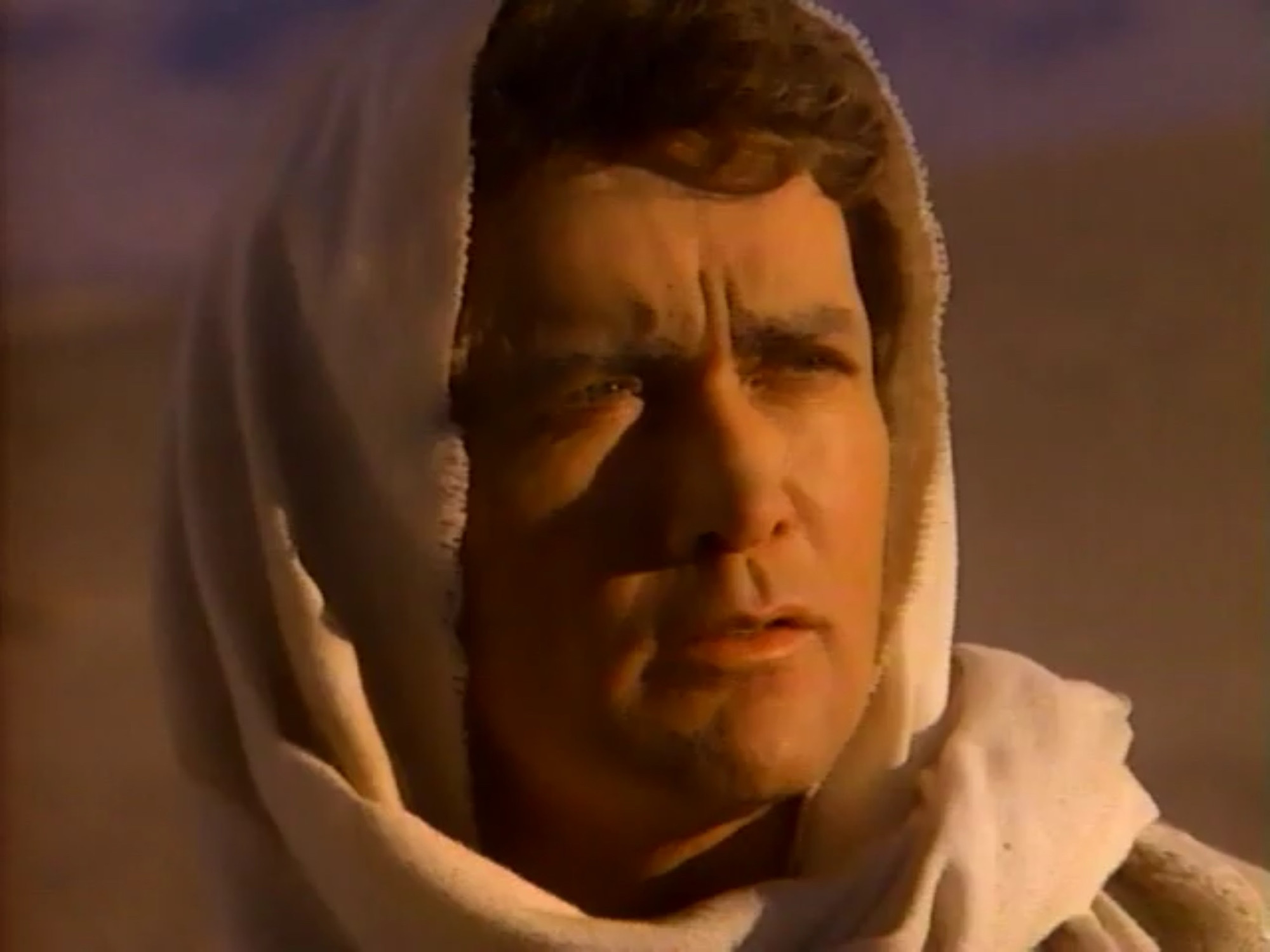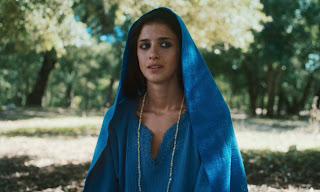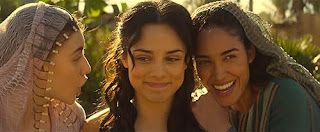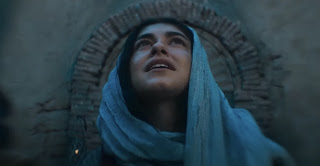According to
Peter Chattaway, a special cinematic episode of
The Chosen was the highest ranking new release at the American box office last weekend.
Christmas with The Chosen: The Messengers charted 4th in the overall box office, but the top 3 were all new releases. Given the series' unusual distribution method, that's not just news for Bible film fans, but also for those tracking the changing relationship between streaming and cinemas.
Sadly, it's not screening in the UK and I don't appear to be on the publicist's radar, so I thought I would continue my series on The Chosen by reviewing the show's pilot, which was also about the Nativity. As Peter discussed in an interview with the series' producer Derral Eves, while both instalments cover the original Christmas story, they do so from different angles meaning neither steps on the other's turf. From the look of the trailer, this 5-minute clip and Peter's review, the new film will be much more focused on Mary and Joseph, and (presumably) the angels that appeared to them.
But as the title of The Shepherd (2019) suggests, the pilot primarily revolves around one of the shepherds who goes to visit Jesus and interestingly while "The Messengers" are the titular characters in the new film, they are not even seen on screen in this one. Given that the film was working on a very low budget that was probably a decision made for budgetary reasons more than artistic ones, but it works well. For me, angelic appearances, be they from The Life and Passion of Jesus Christ (1907), The Nativity Story (2006) or even Netflix's Midnight Mass (2021), never really work. Aside from the sheer over-literalness of them, they also bypass the imagination, and the viewer then has a brief moment to focuses intensely on the film-makers' visual interpretation, before the angels disappear again.
So The Shepherd's approach, which is similar to that of other Jesus series such as 1977's Jesus of Nazareth, is to shine a light on the faces of those receiving the message, but to keep the angels themselves off camera. It works well artistically, keeping the focus on the shepherds and their reactions. Moreover the actual words the angel(s) speak(s) are inaudible. This actually nicely encapsulates the film's overall approach. Much of the central focus of the biblical account, and particularly the words that are spoken, are moved to one side. Instead the focus is on the wider context. Likewise Luke's words which set the context for his gospel, are replaced by the filmmakers own textual introduction
Given that so far I've only seen two episodes of the series and this pilot (not to mention that there is a whole third series coming which nobody has seen yet), I'm a little cautious about extending my observations. Nevertheless this seems like it sums up the series (so far). The Chosen is about providing a a broader, or palpable context for the Gospels. It will be interesting to see how this extends as Jesus' role becomes more significant. It could also make for an interesting comparison with the Brazilian telenovelas, also the product of evangelical filmmakers, and also adding a lot of additional context around the original stories).
The angels sequence doesn't occur until the halfway point of this twenty-four minute episode. The initial focus is on the eponymous shepherd (Simōn), who appears to have reduced mobility in his left leg. He and his colleagues are heading towards Bethlehem. The film cuts towards an interior of a synagogue where a service is taking place and eventually it becomes clear that these men are not only absent from the service, but unwelcome.
This also brings out another theme that seems to be a feature of the series – the opposition between establishment or official Judaism, perhaps we could even read mainstream Judaism, and the Jesus movement. Naturally, the words being read from the scriptures are Micah 5:2-4 "But you Bethlehem... from you shall come forth one who will be ruler over Israel".
This theme is also developed in a parallel, intercut, scene. Arriving in the village, Simōn approaches a pharisee (or at least a man dressed as pharisees tend to be in Jesus films) who seems to be buying spotless" lambs for sacrifice. The shepherd calls him teacher, quizzes him about the messiah and even challenges his answer about the messiah being "a great military leader" by citing another scholar. The 'pharisee' is outraged at his audacity and sends him on his way.*
Simōn's shepherd colleagues leave him behind meanwhile the readings inside the synagogue have moved onto Isaiah 9:2 "he people who walked in darkness Have seen a great light". (This does make me wonder what he's missing. Is there a Christingle service going on in there?) The shepherd pokes his head through the door but is shoo-ed away before he can find out.
But then just as he leaves he meets Mary on a donkey, and Joseph. he gives them directions to a well and, Ben-Hur style he offers them a swig from his canteen. Joseph asks about accommodation and mentions that they are from Nazareth. Simōn starts replying with "You know they say 'Nothing good can come from...'" but Joseph interrupts abruptly with "I know what they say about Nazareth".
It's a nice scene, built on the foundations of all those 'coincidental' meetings from so many biblical films in the past, a good way to ensure the film remains Simōn's story, told from his perspective, but also to showcase what the film-makers can do with the biblical characters. Again it's this pattern of liberating them from the biblical text to make them more rounded, but necessarily therefore more 'fictional', characters.
There follows a montage of sorts with Simōn making his own way back to camp accompanied by prophetic scriptures from the synagogue still ringing out; while his colleagues laugh and joke by a fire. Again it's providing this wider context for the story. Indeed, there's essentially a 'world building' that is at the core of The Chosen which greatly expands on a context for the Gospels, without featuring much of the biblical text, (though Peter notes that the new film is the first Jesus film – aside from the 1979 word-for-word version of Luke – to actually include all of the text of the Magnificat).
Given the focus on Simōn it's surprising that when the angels finally appear, they appear more to his three colleagues than Simōn himself. Whereas they stand in the blinding glow of the light, he is apparently further away. He still seems to hear and understand, but without the full visitation experience. Perhaps this is meant to signify that his meeting with Mary and Joseph was of greater significance, or that he possessed such inherent true faith that he did not need to see a flashy miracle. Either way as he starts running to the stable, his leg is healed and he discards his crutch.
The scene inside the stable is largely wordless and, but for the over-use of slow motion, fairly brief, but as the shepherds depart we do see something that is relatively rare even in Nativity films – the shepherds telling other people in the village about their experience, including a Roman soldier. This is accompanied by a voice-over reciting Isaiah 9:6-7 ("Unto us a child is born...").
However, there's a final encounter with the marketplace pharisee from earlier who asks Simōn is he has "found a spotless lamb for sacrifice". Of course, this is meant to be ironic because Simōn has just "found" Jesus, the sacrificial lamb of God (geddit?). Simōn thinks about it, smiles to himself (as if he understands the scriptwriters joke) and there's a cut to black for the end of the show, which I kind of like.
It's a brief vignette, yet one which even at under 19 minutes feels a little bit stretched out. Given the short amount of material that is being adapted it could have been shorter and taughter, but that doesn't detract from fairly good production values, some nice compositions, and a good central performance. And the writer, director and actor work well together to produce a fairly well rounded character. As a first look of The Chosen, it's not a bad introduction and quite a good way to taek15-20 minutes out to think about the original Christmas story and it's interesting too to see how much things move on between this and the first episode proper of the series.
Nit-picker's Corner
These are some details for my fellow pedants, but I don't consider them to have the same importance with the above...
As with the first episode there's an opening series of titles which here assert that this is "based on the true story from Luke's Gospel". I discussed my thoughts on that in my coverage of the first episode, but here it also adds that "the prophets of Israel had been silent for 400 years". That number is oddly specific for something that is so debatable. Israel (as opposed to Judah) had been disbanded following Tiglath-Pilesar's sacking of the kingdom around 722BC. Judah's prophet's continued and Malachi is usually dated to the decades before 400BC, but many scholars date the book of the prophet Daniel to much, much later (around 150BC). That's not a popular view in the evangelical world from which this film has arisen, but even in those circles it is voiced occasionally.
The prophecies whispered of a coming messiah who would save God's people
*I find this scene problematic for a number of reasons. Firstly ever since reading Katie Turner's thesis about costumes in Jesus films I find the ahistorical visual othering of the pharisees even more troubling than I did before. But this is a low budget production so it's perhaps unrealistic to expect it to do anything beyond mirroring the conventions of the genre. Secondly if this man is a pharisee why is he not only absent from synagogue, but working on the Sabbath? And I'm curious as to how this market location in Bethlehem relates to the site of animal sacrifice in Jerusalem. I imagine that if the numbers of sheep used in the temple were considerable they would have had to be sourced from further afield, but then the pharisee would then surely need someone to help him get them there, such as, well, a shepherd. Lastly, based on my limited understanding, the kind of back-and-forth debate the shepherd attempts to engage in is a common Jewish approach to the scriptures, so it seems odd that the pharisee would be outraged. But perhaps this is the film-makers point, that Judaism in Jesus' time had lost its way.
Like I say these are minor thoughts that come to me, not really substantial criticisms of the film, but I know they will be of interest to some people who read this blog so I thought I may as well share them.
Labels: Chosen (The), Nativity - Mary Joseph






























